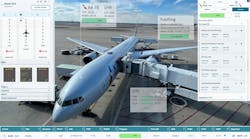Q: Let’s start with the basics. Aircraft connectivity is a broad term. If I’m an aircraft maintenance professional, what does it mean to me?
A: A lot of people think connectivity is a back of the aircraft type of thing — that it’s really like inflight entertainment — and they really don’t pay it much attention because it’s just for the passengers. And while that probably was true five or six years ago, today it’s different. Maintenance technicians need to have a proactive role in finding out what connectivity is because the next big thing that’s going to happen in aviation will be powered by connectivity. Here’s what I mean. People talk about automation in cars. Tesla has self-driving cars and all these big things are happening. These types of technologies are arising and they will be adopted over time. Likewise, there’s going to be more automation in the cockpit and more automation in flight. And that only happens because of connectivity.
Q: So where should a maintainer’s focus be in terms of the aircraft?
A: They need to look at the front of the aircraft. We’re seeing applications where a maintenance technician will walk up to the aircraft with a tablet to download engine data, to get service logs, diagnostics and all of that. They can even make a logbook entry for the aircraft wirelessly or determine what parts are on the aircraft.
Q: When someone is buying connectivity equipment for a business jet, what are the factors they should be considering?
A: Just as when you buy an aircraft, the first thing to think about is how you want to use the equipment – what do you want it to do for you? Do you need email? Do you want to browse the web? Send files? Is it important for you to stream Netflix? All of this will drive you to the best solution. Also, when you start looking at aircraft connectivity options, those tend to be more mandate driven. Maybe you need the ability to fly the FANS-1/A routes and satisfy those operational requirements. Or maybe you want to get rid of one of your HF radios and move to Satcom instead.
Q: From a maintenance standpoint, what factors would be important when you’re considering a purchase of this type and when you’re considering what it’s going to take to maintain and support this connectivity equipment?
A: You’ve got to understand what it is you’re actually buying. I think that a lot of people end up buying a system and not really understanding what the capabilities are and what they want to do. But when you’re thinking about the maintenance, it’s really important to understand the complexity of the system. Does the maintenance technician understand the complexity? Understanding network systems is critically important. More and more we are working closely with our customer’s IT technicians. So you’ve got a flight department technician looking after the aircraft parts, and the IT department looking after the networking. Also, are there any special tools that are needed, or can you maintain it with a laptop? What does the support from the manufacturer look like? Because a lot things can be supported over the phone and with software updates.
Q: That must present a challenge to an OEM, a manufacturer such as you?
A: Yes. We look for different ways to support customers using things like remote logins or having them to share the login files so we can steer them to a solution. Training is also important. Satcom Direct offers an Aero IT Program where maintenance technicians are trained and certified. I would recommend this to anyone who’s working on large business jets like Gulfstreams or Challengers. Networking skills are essential. The technician of the future needs to be part mechanic and part IT professional.
Q: What are the challenges involved in installing and properly maintaining aircraft connectivity systems and what are the cost drivers for maintenance?
A: The good news is that the systems are reliable. Technology has evolved and people are offering one-box solutions. So while it’s still a complex system, they only have to deal with one box, and swapping it out may fix the problem.
Q: Does the complexity also drive cost of maintenance?
A: Possibly. The first time you go through something like this it can be expensive because people are learning as they go. Sometimes things aren’t broken, they are just misconfigured. Maybe they left out a digit in the Wi-Fi password or put a zero instead of an O. Those types of small things can cause big problems, and if a technician has to spend a few hours to figure that out it can cost the customer a lot of money.
Q: These technologies and products are changing so rapidly. How are we as an industry dealing with the technical and obsolescence challenges that this presents, and what can maintenance professionals do to keep up?
A: Owners and operators are understandably frustrated about obsolescence. We all have a drawer full of old phone cables, and just like those phone cables become obsolete, now your $60 million business jet has become obsolete. When your new iPhone doesn’t work you’re thinking that something’s wrong with your aircraft. We often hear from directors of maintenance for Fortune 50 companies who are worried about a new phone release. They know that their CEO or CTO is going to have one and be on the plane the next day trying to use it. We have a support program to help customers stay ahead of that and believe we should be the guys staying up at night worrying about this issue, not you.
Q: So what does the future hold for connected aircraft and what can maintainers expect to be the next big thing?
A: They can expect more connectivity. Today we can’t imagine the world without the internet. That’s exactly what’s going to happen with connectivity and airplanes. It’s going to be as commonplace as GPS. Everything that flies will have some sort of connectivity option. That’s how the UAVs are going to work within controlled airspace. That’s how Amazon’s going to deliver packages, and Google’s going to do all the things they want to do. There is just no question that the next big thing in aviation is going to be driven by connectivity.
Q: So it’s happening and we need to be ready?
A: Everyone in the industry, including maintainers, needs to become smarter about connected aircraft. Maintainers are going to maintain aircraft differently because of connectivity. Pilots are going to fly airplanes differently because of connectivity. And passengers are going to expect different things because of connectivity. It’s completely changing the entire industry. So you either have to get on board or get out of the way.
TrueNorth designs and builds the technology that powers the connected aircraft cabin and flight deck, tackling the rapidly changing landscape of mobile devices today and tomorrow. Fortune 100 business jet operators trust the company’s inflight communications systems, and leading avionics manufacturers rely on TrueNorth for their own connectivity systems. Effortless connectivity for smart phones and other mobile devices, and flexible, upgradable systems empower passengers, crew and maintainers. For more information visit truenorth.aero.



